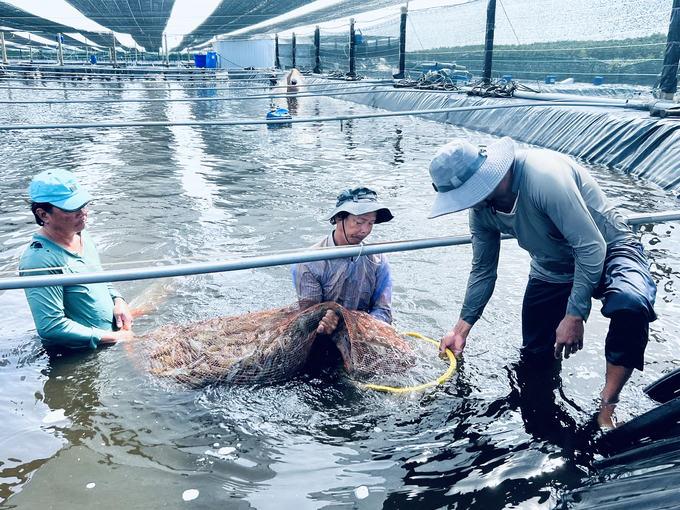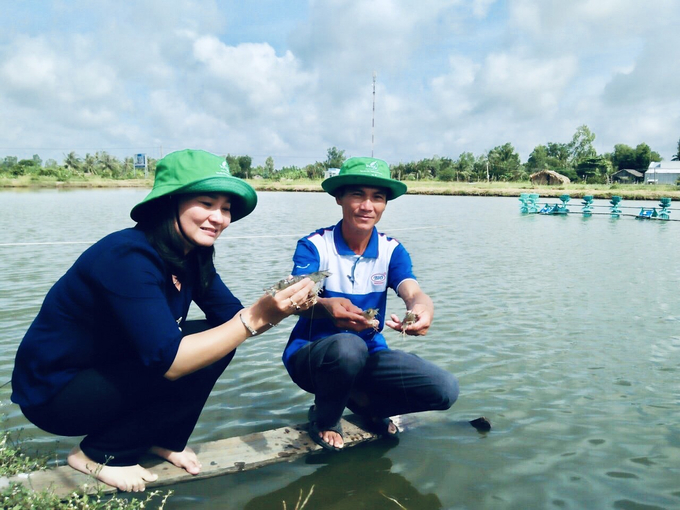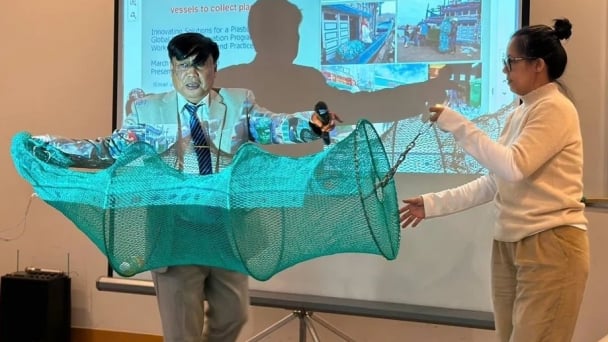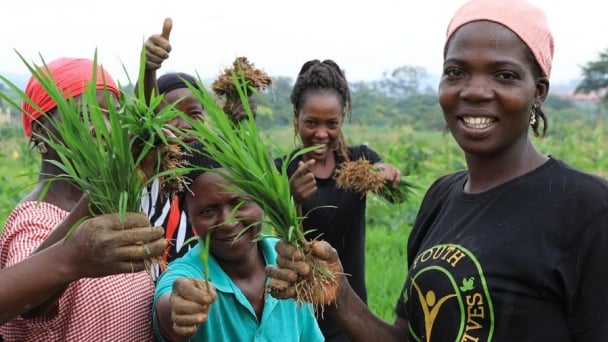May 16, 2025 | 01:04 GMT +7
May 16, 2025 | 01:04 GMT +7
Hotline: 0913.378.918
May 16, 2025 | 01:04 GMT +7
Hotline: 0913.378.918
Shrimp accounts for nearly 80% of Soc Trang province\'s seafood exports and contributes to 10% of the national shrimp export turnover. This achievement is the result of the great efforts by households and businesses in developing effective shrimp farming models utilizing high technology.
Despite its economic efficiency, the high-tech intensive shrimp farming model carries a high risk of environmental pollution due to its considerable source of water and food waste. With this issue in mind, many farming establishments have invested in waste treatment systems in aquaculture development process, ensuring the harmony between economic benefits and environmental protection in the farming areas.

The high-tech intensive shrimp farming model carries high environmental risks if water and feed waste are not managed effectively. Photo: Trong Linh.
The entire shrimp farming model belonging to Mr. Ly Van Rat in Cang Buoi hamlet, Hoa Dong commune, Vinh Chau town covers an area of over 49,000 square meters; 90% of which is equipped with sedimentation ponds, water treatment ponds; the three rearing ponds only account for 1,200 square meters each. Following the 3-stage intensive shrimp farming process that utilizes bottom tarpaulin, Mr. Rat has carefully designed a diagram of shrimp farming in the form of water circulation.
Accordingly, when a water change siphon occurs, shrimp shells, shrimp manure and leftovers from the pond will be separated by filter bags, the remaining solid waste will be discharged into the waste storage channel, and the input water source from the main water supply channel passes through 6 settling ponds. The water from the treated settling pond is stored and supplied to nursery or rearing ponds.
Thanks to a closed chain circulating water treatment system, Mr. Ly Van Rat\'s farming model has limited the source of wastewater discharged into the environment, produced shrimp efficiently as well as reduced the risk of disease.
Mr. Ly Minh Rat shared: "Due to the current ineffective water treatment system, shrimp often have intestinal infections in the liver, leading to white feces disease. After switching to the intensive farming model following the water circulation process, our shrimp have grown strongly with a normal diet. The family has harvested at least 20 tons of shrimp this year".
Similarly, Mr. Chau Minh Tam from Long Phu Center, Long Phu district also focuses on waste treatment through a biogas system following a 3-stage high-tech farming process to protect the environment. With the biogas system, all wastewater, shrimp manure and shrimp shells from the siphon pit will be put into the biogas cellar for treatment before being put into the settling pond and discharged into the environment.
Thanks to the biogas system, waste from shrimp farming will have a lesser impact on the environment; the gas from the system will also be cleaned to serve the family\'s cooking activities, which will subsequently reduce living expenses. In addition, shrimp shells are retained through filter bags, which can be used to nurture the fields.

The 3-stage intensive shrimp farming model brings high economic efficiency to the farmers. Success rate of the model is estimated at approximately 75%. Photo: Trong Linh.
Mr. Chau Minh Tam from hamlet 2, Long Phu town, Long Phu district, Soc Trang province said that: "The 3-stage shrimp farming process allows for easier control of diseases compared to that of traditional earthen ponds. I can manage the pond environment, and the surrounding environment is treated with biogas, so it does the outside environment is unaffected. As a result, the farming process will not cause troubles for neighbours as well as people in the area".
Soc Trang province currently has more than 4,000 hectares of high-tech shrimp farming, concentrated mainly in farms and farming households located in the districts of Tran De, Long Phu, Cu Lao Dung and Vinh Chau town. According to the survey data collected by the Department of Natural Resources and Environment, the volume of waste in intensive and semi-intensive shrimp farming activities is substantial at between 4.81 and 6.93 million cubic meters per year for sludge and between 433.2 and 563.1 million cubic meters per year for wastewater. If this large amount of waste generated from shrimp farming is not collected and treated properly, it will greatly affect the environment.
In addition to technical process support and credit capital to develop effective farming models, the provincial agricultural sector has also developed synchronous solutions to develop freshwater shrimp farming models that promote sustainable benefits and environmentally responsible production.
Ms. Quach Thi Thanh Binh, Director of Soc Trang Sub-Department Fisheries said: "The Department has consulted the Provincial People's Committee on strengthening the management of shrimp farming facilities and households in the province to protect the environment, boost efficiency and assure compliance with regulations. We will also continue to strengthen, consolidate and establish new cooperatives for collective economic development. Because the land in the province is divided, it is necessary for people to cooperate in producing efficiently as well as promoting the community spirit in environmental protection.

Ms. Quach Thi Thanh Binh, Director of Soc Trang Province\'s Sub-Department of Fisheries, inspecting the shrimp farming model at Hoa De Agriculture and Fisheries Cooperative in Hoa Phung Hamlet, Hoa Tu 1 Commune, My Xuyen District. Photo: Trong Linh.
Based on the local governments' recommendations, we will design manuals to help farmers with activities such as the construction of ponds, annual application of technical processes, etc.; as a result, farmers can easily understand and apply the model to raise efficiency sustainably.
With special features including a fast production cycle, large-sized shrimp farming, minimal disease damages to shrimp due and so on, the high-tech intensive shrimp farming model is currently the development trend that Soc Trang province highly encourage farmers to invest and replicate in order to improve economic benefits.
However, environmental issues must be coupled with economic benefits to promote this farming model's effectiveness as expected, contributing to sustainable growth for the key economic sectors in Soc Trang province. On the other hand, Soc Trang province's seafood exports has reached over 1 billion USD for the second time in 2022.
Translated by Nguyen Hai Long

(VAN) Data from 10,000 farming households will help professionalize production organization and support the implementation of the One Million Hectares Program for High-Quality, Low-Emission Rice Cultivation.

(VAN) FAO Director-General QU Dongyu marks International Day of Plant Health at NENA conference.

(VAN) Deputy Minister of Agriculture and Environment Hoang Trung affirmed that floriculture and ornamental plants are a growing industry that receives significant global attention.

(VAN) The three staple crops dominating modern diets – corn, rice and wheat – are familiar to Americans. However, fourth place is held by a dark horse: cassava.
/2025/05/10/4037-3-223011_495.jpg)
(VAN) Remote sensing technology is becoming an indispensable tool in monitoring resources, developing modern agriculture, and protecting the environment in Vietnam.

(VAN) The trash bag used on fishing vessels can withstand rough sea conditions, including level 8 to level 10 winds and waves. Notably, it can be hung anywhere on the boat.

(VAN) African leaders launched the Kampala Declaration on Building Resilient and Sustainable Agrifood Systems in Africa, marking a bold step toward transforming the continent's agriculture.